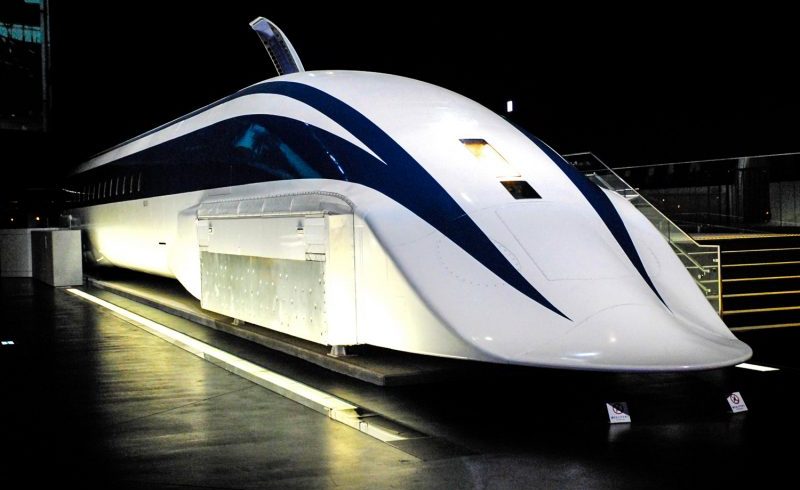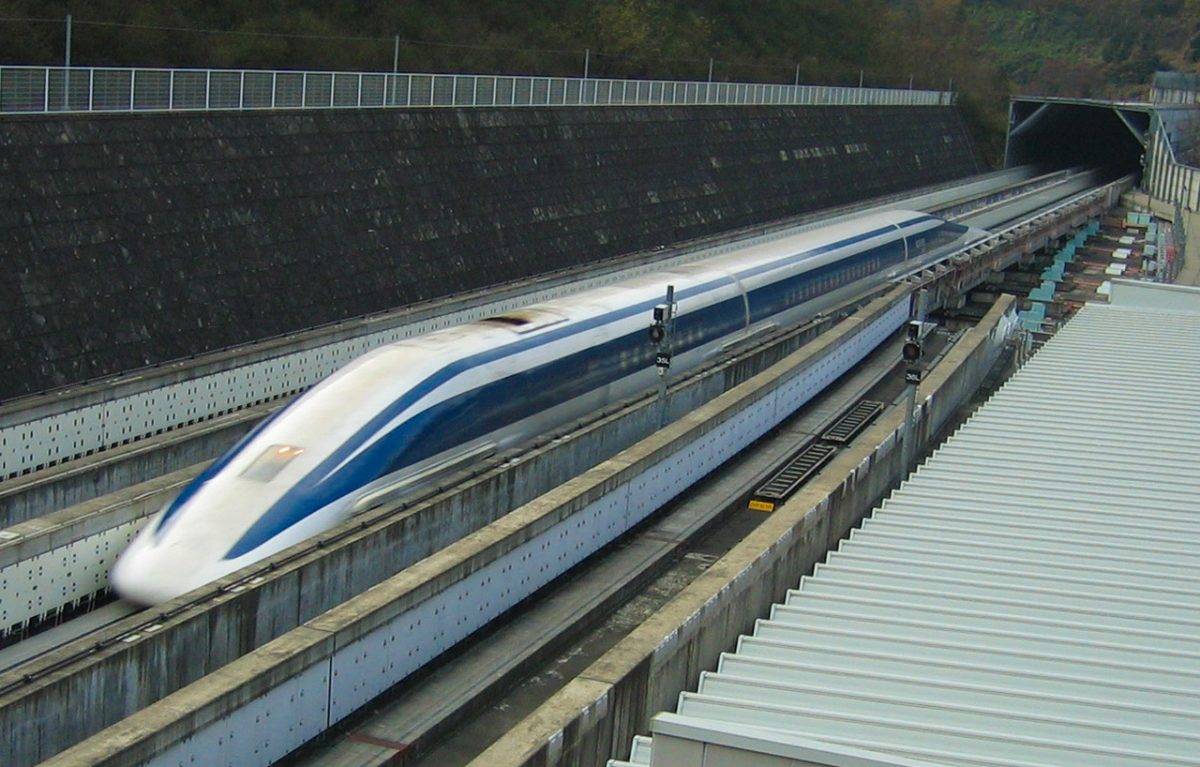Imagine rushing across the Japanese countryside at astonishing speeds. The wheels of your vehicle do not even touch the ground. In fact, you are floating! This dreamlike experience is will soon be a reality thanks to Japan’s famous Maglev bullet trains, the fastest train in the world.
Japan is already well known for its extensive Shinkansen train system, which has been in operation since 1964. The world’s current fastest trains, however, will take a backseat to the Maglev when commuter transportation becomes available in a few short years.
How Maglev trains work
SC Maglev, or superconducting magnetic trains, were developed by the Central Japan Railway Company and the Railway Technical Research Institute beginning in the 1970s. Maglev trains work on the principle of magnetic repulsion between the cars and the track. The word maglev is actually a combination of the words “magnetic” and “levitation.” The magnetic levitation, or floating of the train, is achieved through the use of an electrodynamic suspension system, or EDS.
The rails, or guideways, contain two sets of cross connected metal coils wound into a “figure eight” pattern to form electromagnets. On the train itself are superconducting electromagnets, called bogies. When stopped, the train rests on rubber wheels. To begin motion, the train moves forward slowly on these wheels, allowing the magnets beneath the train to interact with those of the guideway. Once the train reaches 150 kilometers per hour (93 miles per hour), the magnetic force is strong enough to lift the train 100 milimeters (4 inches) off the ground, eliminating friction to allow for increasingly high speeds.
The same magnetic forces that lift the train also move it forward and keep it centered within the guideway. This is the same technology used by Tesla’s Hyperloop, which makes the ride smooth and the train exceptionally safe.

Maglev top speed
What is the Maglev train’s top speed? In April 2015, a manned superconducting Maglev train broke two previous land speed records for rail vehicles. The train was clocked at 603 kilometers per hour or 375 miles per hour. This is much faster than the Maglev trains already operating in Shanghai, China, and in South Korea, which run at speeds of 268 to 311 miles per hour and 68 miles per hour, respectively.
The Maglev train has also exceeded previous Shinkansen world speed records in trials at the Miyazaki Test Track. Most Shinkansen trains operate at speeds of about 500 kilometers per hour (200 to 275 miles per hour). As new technologies are developed and instituted, future trains may achieve even greater velocities.
Did you know? In sixty years of operation, Japan’s high-speed rail lines have had zero fatal accidents, making them one of the safest forms of transportation in the world. The Maglev service intends to keep up that spotless record.
The Japanese Maglev train route
In 2009, the Maglev system was approved and entered commercial construction. The linear Chuo Shinkansen line is planned to link Tokyo and Nagoya by the year 2027. The trip is expected to take only forty minutes – faster than either flying between the two cities or taking the one and a half hour trip on the current Tokaido Line, available with the Japan Rail Pass. The proposed route will include stops at stations in Shinagawa, Sagamihara, Kofu, Iida, and Nakatsugawa.
The original goal of the Maglev project was to produce a train that could cover the route from Tokyo to Osaka in less than one hour. This will be achieved when the Maglev line is extended from Nagoya to Osaka, expected to be in operation by 2045.
Eighty percent of the 286 kilometers (177 mile) Maglev bullet train track will be located underground, passing under urban sprawl and mountainous terrain. The project is expected to cost the equivalent of 55 billion dollars.
When completed, the train will include sixteen carriages capable of holding one thousand passengers. At present, the public have been invited to take part on Maglev test rides. Tourists can visit the SC Maglev Parkway in Nagoya or the Yamanashi Prefectural Maglev Exhibition Center near the town of Otsuki to learn more and view Maglev test runs.
[banner-en]
The Chuo Shinkansen
The Chuo Shinkansen (or the Tokaido Shinkansen Bypass) is a new rail line which will connect Tokyo and Nagoya. It is being constructed in phases and will use cutting-edge Maglev (Magnetic Levitation) technology.
Once completed, the line will provide a more direct line between the two cities and will reduce travel time by around 50% (down to 40 minutes) in comparison to the current Tokaido Shinkansen line. The route will be extended to Osaka once the project progresses – the whole journey will take just 67 minutes.
Passengers will be able to get tickets for the new line in 2027. The trains will travel at a maximum speed of 505 km/h (the world record is 603 km/h).
The route map will initially include 6 stations: the Shinagawa Station, the Nagoya Station, and the prefectures of Kanagawa, Yamanashi, Nagano, and Gifo. It will include 256.6 km of tunnels, 11.3 km of bridges, and 4.1 km of rail beds.
The Central Japan Railway Company (JR Central) is overseeing the project which will cost an estimated 5.52tn yen ($52b). They have ordered 14 new Series L0 (L zero) Maglev trains which are currently conducting long-distance trials on the Yamanashi Maglev test line.
The future of high-speed trains
The Maglev may hold the current world records, but it will have its competitors. Japanese prime minister Shinzo Abe has proposed selling the technology to the United States to build a Maglev line between New York and Washington.
At the same time, plans are underway for the Hyperloop train line from Los Angeles to San Francisco, California, USA, that may reach speeds in excess of 700 miles per hour. In the meantime, the high speed hopes of Japanese citizens and tourists alike rest squarely on the Chuo Shinkansen Maglev line.

Hi am Stephen from Nigeria. I will like to be a Maglev sales manager here in Nigeria. it will be nice for people here.
I think Australia needs to build a Maglev line linking Sydney to Melbourne via Canberra. It is practically a straight line.
Little has ever been researched on magnetics, but you have finally discovered a propulsion system that can move satellites into outer space. Current rocket systems are limited and counter productive as are nuclear power plants and we can’t even neutralize the spent rods. But the idiots are still making the nuclear material. The plants should be dismantled and the manufacturing of nuclear material banned. The only feasible way to rid the nuclear waste is to send it into outer space until some other way to neutralize it is found. Don’t you people have any imagination? I’m a metallurgist 86 years old, too old to tackle the job. The answer to copy metallic material in the flying saucers found probably can be solved by powered metallurgy, using both heat and high pressure molding. We have found out already that the properties of aluminum changed in the production of the shell protective material in the saucers. Magnetic fields is the only logical propulsion system that will work in space travel. Good work on your excellent work so far.
You should know flying saucers are remnant of world war one zeppelins that broke loose from their mooring towers. The cigar mothership, the trailing Hydrogen/helium bladders painted in radium which decayed over time capturing alpha particles and building a couple megaelectron-volt electric charge that equalized when any aircraft snagged a trailing cable, or the tictac formed when one zeppeling broke in half. All zeppelins. Dont think for an instant it didnt affect paranoid americans. The mere idea of UFOs existing pushed them to develop technology.
The Japanese Maglev train is the best mode of communication WHICH CAN GIVE US THE FREEDOM TO TRAVEL NEAR ABOUT TO A TIME MACHINE SPEED.these kind of technology also gives super speed to the commuters in case of long distance travel. The Hyperloop technology is also very surprising but technically it is widely been constructed.Lets join the connectivity of these network.
Greetings.
I am interested in the proposed route of the Mag-Lev (Linnear) train line through the Kani City (Gifu Prefecture) area. Specifically, I am being told that, as planned currently, the Mag-Lev Linnear train would emerge from a tunnel in the Ogaya district of Kani City. If this in fact occurs, the above-ground train route would destroy the current studio and kiln of working artist Yoshida Yoshihiko, and would also seriously impact other neighbors (and historic pottery kiln sites) in the Ogaya neighborhood.
Please let me know about the proposed route through the Ogaya area of Kani City (Gifu Pref.), and of any thoughts about impacts to the neighborhood there.
It all seems like magic. What propulsive force can a maglev/linear motor system generate? is the propulsive force dependent on the speed? can such a system generate 3g accelerations over short distances? What are the energy requirements of a single loco without a train behind? How can I initiate an joint project? Could someone who knows these answers please E-mail me? Please.